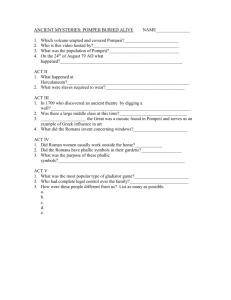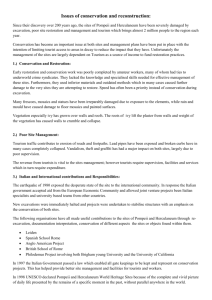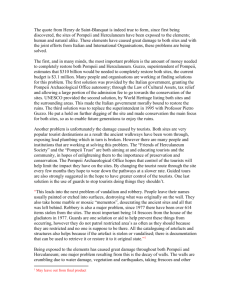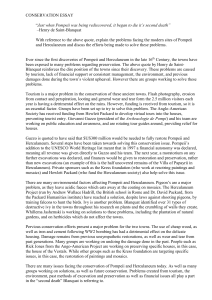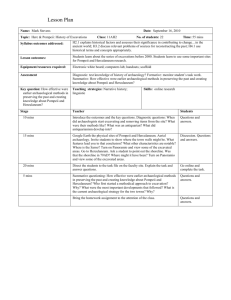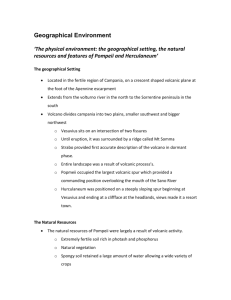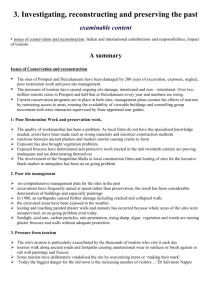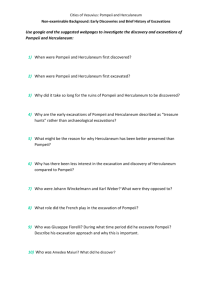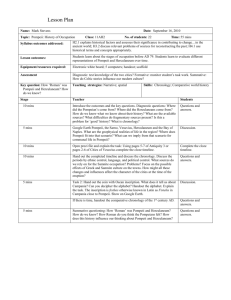Conservation
advertisement
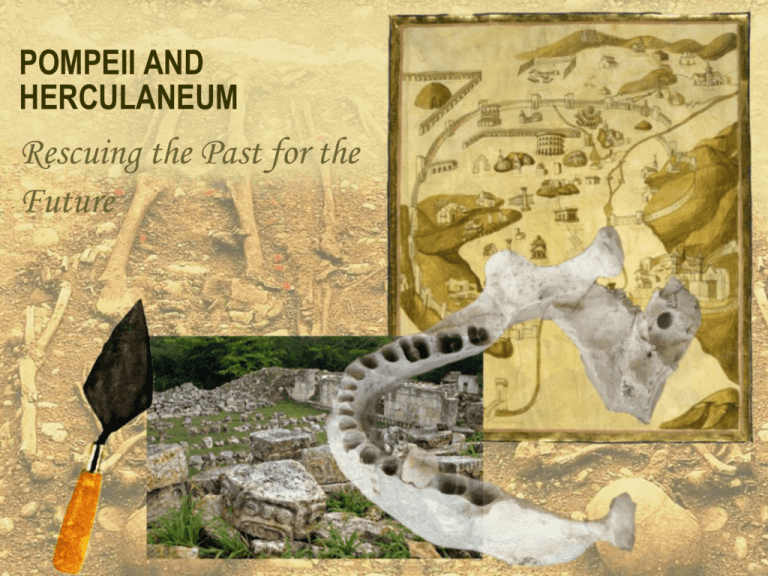
POMPEII AND HERCULANEUM Rescuing the Past for the Future Know the Syllabus Issues of Conservation and Reconstruction Italian and International contributions and responsibilities Impact of Tourism Ethical Issues CONSERVATION Is defined as… “the preservation of cultural material for the foreseeable future in a way that allows the maximum information to be retrieved by further study and analyses.” Kate Foley Positive Aspects. It safeguards the physical fabric of the object from loss and deterioration Negative Aspects. Conservation can also be destructive- by treating the object it can destroy valuable information contained within the dirt or corrosion products surrounding the object. RECONSTRUCTION Measures to preserve historical materials and are based on accurate duplication of documented features through archaeology Positive Aspects. It provides greater impact and interests for tourists, creating almost outdoor museums Negative. It can be done in an unsympathetic way with materials not compatible. The reconstructions are criticized as largely imaginative since they reflect present mindedness rather than the object as it existed in ancient times. THE SECOND DEATH? The excavated cities are vast open-air museums which together include almost 2000 buildings, many kilometres of paths and roads, and thousands of square metres of frescoed walls and paved mosaic flooring still vulnerable to decay. There are many causes of deterioration and problems facing the sites of both Pompeii and Herculaneum. Poor restoration work on the sites has been done by local firms with little specialised knowledge of restoration techniques and in some places incorrect construction methods have been What are the Problems? “Just when Pompeii was being rediscovered, it began to die it’s second death” –Henry de Saint-Blanquat Insufficient finances Lack of sufficient care in excavated parts Unsympathetic restorations of the past Nature; weeds, acid rain, sunlight, wear and tear Human impact; negatives of humans MONEY, MONEY MONEY 1997 a special law was passed giving the superintendant the right to retain gate money. 1997 a law declaring private donations tax deductible World Monument fund contributed $ 600,000 over 3 years to finance an assessment of the site and draft a plan for restoration. Funding from the European Union is being used to create facilities such as bookshops, and restaurants, which in turn will generate funds for conservation projects European Union; Any one read Italian?? INTERNATIONAL AID TO THE RESCUE Justification for Inscription on UNESCO; WORLD HERITAGE LIST The Committee decided to inscribe this property on the basis of criteria (iii), (iv) and (v), considering that the impressive remains of the towns of Pompeii and Herculaneum and their associated villas, buried by the eruption of Vesuvius in AD 79, provide a complete and vivid picture of society and daily life at a specific moment in the past that is without parallel anywhere in the world. New focus New approaches to "Towards an understanding of conservation are being the shape of space at VIII.7.115, Pompeii: preliminary implemented. Instead of results from the 2006 season." concentrating on single Steven Ellis, Gary Devore, buildings, restoration and 2006.. conservation are focusing on whole insulae in order to achieve a more integrated result. Bureaucracy. Government red tape is blamed for some of the inefficiencies at Pompeii. “If I have to fix a broken wall,” said Pietro Giovanni Guzzo, the superintendent of the ruins, “I first have to put out a tender for an architect to evaluate the damage. “Then I have to put out a tender for a company to fix the wall. Then I have to see if I have enough money in my budget to pay for the repair, and then finally the work begins. Unsympathetic restoration of the past Amedeo Mauri director from 19241961 made an effort to improve the infrastructure of the two towns. Unfortunately many of the materials used were mostly concrete and steel which were not only different to the original materials but ultimately damaged the original structure even further.The alkaline in the masonry reacted with the ancient walls producing soluble salts which migrated to the surface causing the surface to crumble as in the House of the Coloured Capitals. Scaffolding and roof erected over the remains of a two-storey building in Pompeii. In the lower right of the slide, a Perspex sheet has been placed over a painted sign A case of poor restoration House of Meleager A new timber roof erected on the House of Meleager in Pompeii was poorly designed and could not support the weight of the tiles and collapsed INTERNATIONAL ARCHAEOLOGISTS TO THE RESCFUE In 1990 an International team of Archaeologists, Conservators planned a rescue mission for the decaying house. Rotting wooden beams have been replaced with new ones stained a rich dark brown, mosaic floors scrubbed to a bright white and glossy black, and wall paintings cleaned and restored to better show their deep red, yellow, and blue hues RISING DAMP/FLOODING OF SUBURBAN BATHS Monica Castaldi and Giorgio Torrata, structural engineers have been commissioned to study ways in which the water rises in order to channel it better in the future Drainage, Rising Damp and Humidity Herculaneums Suburban Baths are the best preserved bath complex. The main problems facing its preservation are humidity. The baths are in fact saturated both by surface water that drains off the domus above and by groundwater as it flows down to the sea. This has led to deterioration of the vault linings of the tepidarium and has caused the Superindendant to close the building to the public The Solution- Laser Technology Herculaneum Conservation Project In 2006 trials were carried out to see how laser scanning could help, not only in documentation but monitoring of progress of decay. This would allow more informed decisions about conservation but also preserve the rich visual material for future generations DON’T WALK ON THE ?????? INSTABILITY OF WALLS/ FLOORS AND CEILINGS House of the Wooden Shutters Palaestra in Herculaneum INVASION OF IVY The roots of ivy are very invasive and contribute to the disintegration of mortar and plaster. The weight of such vegetation also damages unsupported walls. NOXIOUS VEGETATION The Pompeian soil is very fertile and allows plants of all types to invade cracks in walls and open areas of dirt. Amongst the species of plants causing problems ,the acanthus whose leaves adorn corinthian columns and walls, wild strawberry, ivy, lichen and mosses. Henry De St Blanquet identified 31 types of parasitic plants, which over time can dislodge tiles and mozaics, weaken mortar which destabilizes walls. Large root systems can also undermine foundations of buildings and invade drainage systems, adding to the existing problems of water damage. Solution; REPLANT WITH THE ORIGINAL SPECIES A research project was designed by the University of Sheffield to retrieve evidence for the date, layout and landscaping of this major sanctuary. Work began in 1998 and was completed in 2007. REPLANTING ORCHARDS Archaeologist Wilhemina Jashemski made an extensive study of the gardens, orchards and vineyards within the walls of Pompeii. Using plaster casts of the cavities, which formed around the roots of trees and vines and the analysis of pollen found in the ash, Jashemski was able to identify the plants that were growing at the time of the eruption. This orchard includes olive and fruit trees and grapevines. A section of the city wall can be seen in the foreground while Mount Vesuvius dominates the background. Restored Garden in House of Venus in the Shell Weathering, Wear and Tear Buildings, artifacts and surfaces have been exposed to the natural errosive processes of wind,sun and rain. In the 20th century the increasing acidic nature of rain from pollution has increased the damage to surfaces. EXPOSED LEAD PIPES These exposed lead pipes carried water to houses in this street in Pompeii. Judging by the relative height of the doorstep and the kerbstones, the pipes would have been quite close to the surface when originally laid. Note the evenly cut and precisely laid kerbstones. Exposure to sunlight and acid rain Solution; Via D’Ell Abbondanza Project ( Italian see pompeiisites.com ) The restoration project avails itself of an advanced 3D technology supplied by the Kacyra Foundation of the American firm bearing the same name which invented the three-dimensional laser scan system. Thanks to the surveys which have been carried out, a 3D data bank of the area of the Fori Civili in Pompeii has been created. As a consequence, the project of restoration and protection of the wall paintings of Regio IX, Insulae 7 and 11 has been developed. The restoration work will be completed in January 2005. Light Exposure to painted walls, frescoes and paintings Problems with wall paintings is the high calcium content which dissolves under the influence of acid rain Artists in ancient Pompeii painted the town red 2,000 years ago with a brilliant crimson pigment that dominated many of the doomed city's wall paintings. They were protected by a protective layer of “ punic wax” Scientists now believe that a chemical reaction takes place between chlorine elements in rain and either the wax or the cinnibar to produce the blackening The wall at right shows the heavy damage due to blackening of cinnabar in the Poppea's villa in Oplontis Salts coming to the surface, fade and damage outdoor frescoes. Stabilizing Frescoes Frescoed walls absorb moisture from the atmosphere. The moisture carries to the wall soluble surface salts that effloresce and injure the fresco pigments. To halt such injury water-permeable fixatives may be applied to help stabilize the pigment and prevent it from flaking off. A more drastic treatment is transfer, by which the mural and upper layer of plaster are cut away from the wall altogether and made fast to a new support. A major instance of successful transfer was carried out on many frescoes unearthed at Pompeii. PROTECTION AND STORAGE Feral Dogs Solution; Guards and strict instructions to tourists, not to feed the dogs DON’T FEED OR PAT THE DOGS!!!!!!! Pigeon Poo!!! And its solutions- Trained Falcons NUMBERS NEED TO PROVIDE SPECIAL AMENITIES FOOD/TOILETS/GAR BAGE WEAR AND TEAR FERAL DOGS By feet and backpacks brushing against walls TOURISM negatives THEFT & VANDALISM Frescoes stolen from House of Chaste Lovers BODY OILS FLASH PHOTOGRAPHY Tourism-A Double edged Sword Each year Pompeii alone admits 2.5 million tourists through its gates. The general movement adds to the wearing down of street surfaces, particularly in frequented areas like the Forum complex. Accidental brushing as well as deliberate touching of walls, columns and frescoes allows perspiration and body oils to react with the ancient surfaces. Flash photography in the past has magnified the damage caused by light exposure. Looting and vandalism has currently become a major security problem for Management. RESTRICT AREAS AT RISK Have varying tour routes Less than ¼ of the excavated town is now accessible to the public. In 2006 only 16 monuments, villas and houses could be viewed as opposed to 60 in 1956 STOLEN POMPEII FRESCOES-2003 Italian police have recovered two famous frescoes that were stolen last weekend from a house in the Roman city of Pompeii, near Naples. The 1st Century frescoes were found at a construction site close to the historic city, after roadblocks were set up across the whole of Naples province. The authorities said they had already been packed, and that the aim may have been to smuggle them abroad. Both panels were damaged during the theft. Pompeii has a long record of art thefts. A chronic lack of resources means there is a shortage of security staff, which forces the authorities to keep large areas of the site closed to the public. Solutions; Superintendant Guzzo Guards 2. Upgrade CCTV system International Legislation and prosecution for traffiking in illicit cultural property. Significant houses fitted with alarms 1. SOUND MANAGEMENT The combined sites of Pompeii, Herculaneum, Stabia and Oplontis are managed by Superindent de Archaeologica di Pompeii, a regional agency of the Italian Ministry of Culture and Environment. The current director is Pietro Guzzo whose initial approach was to place a moratorium on new excavations http://www.pompeiisites.org/ Click on Work in progress and make brief notes about the varied projects Choose at least 2 International Projects and make brief notes about the aims, work carried out and any results. CONSERVATION PROJECTS Superintendenza Guzzo Herculaneum conservation project Hewlett Packard British School Of Rome Philodemus Project University of Nth Carolina 3D laser Scanning of Suburban Baths World Monument Fund 1996 Kress Foundation UNESCO World Heritage List-1998 Anglo-American Project Academy Projects Pompeii Trust Bradford University DIAPREM & Kacyra Foundation Architectonical survey project PRACTISE RESPONSE Sir Henri De Saint- Blanquat once said, that the moment P & H began to be excavated , they began to die their second death. Discuss this statement in relation to Conservation and Reconstruction efforts in the two towns 600 words
